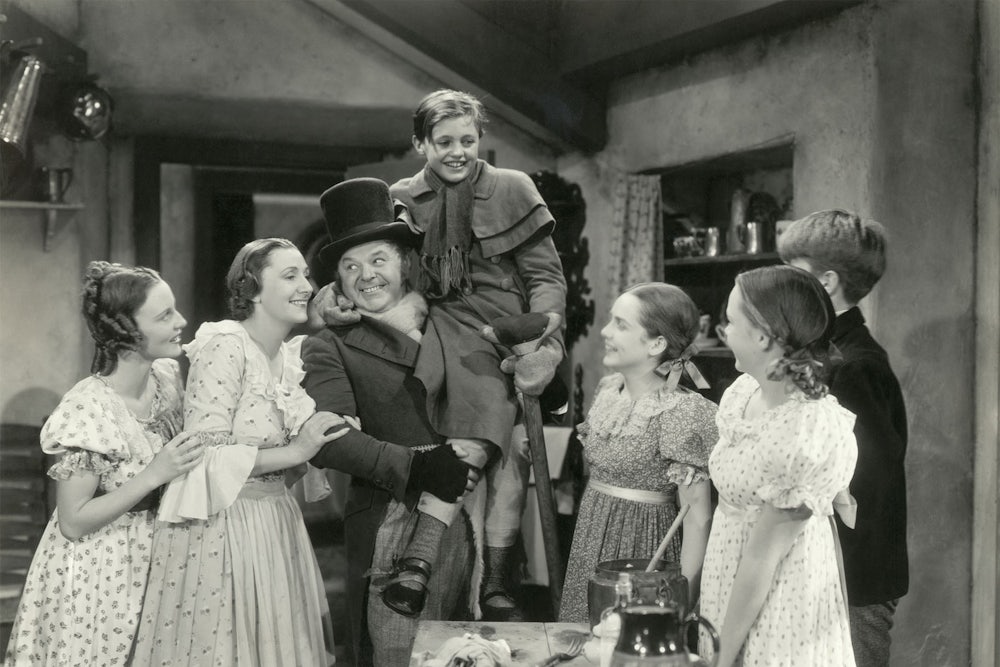’Tis the season to rehash one of the most famous medical mysteries of canonical literature, plucked from the pages of what must be one of the most lucrative pieces of noncopyrighted source material of all time: the tragic life and death (and, ultimately, redemptive resurrection) of Tiny Tim in Charles Dickens’s A Christmas Carol.
You know the story, but in service of the journalistic convention that requires me to summarize it briefly anyway, here goes: Ebeneezer Scrooge is a wealthy-but-miserly jerk who gleefully opposes and eschews charitable giving, all while underpaying and overworking his devoted employee Bob Cratchit. One Christmas Eve, he receives a series of visitations from three persuasive specters who guide him through scenes from his past, present, and future. These experiences imbue Scrooge with an apparently permanent sense of yuletide benevolence, transforming his own life and those around him in the process. The central moral device is a pathetic but kindhearted boy named Tiny Tim, the youngest of Cratchit’s sizable brood, whose devastating demise is ultimately averted by the happy ending. (If, like me, you favor the muppet adaptation of the 1990s, you may forever envision poor Tim as a mini–Kermit the Frog.)
Dickens suggests that Scrooge’s consequential dream of paranormal activity, which subsequently inspires him to vastly improve Cratchit’s pay and working conditions, is the thing that allows Tiny Tim finally to thrive as he grows up, as opposed to ending up in an ominous vignette featuring his surviving family weeping beside a single crutch. But what exactly ailed Tiny Tim, and what saved him? Unpacking the evidence tells us a lot about what Dickens got right and wrong about nineteenth-century London, as well as shedding light on why there are still so many Tiny Tims today.
Right at the beginning of the 1843 novella, which Dickens allegedly churned out in six weeks to get out of debt, we get some insight into Scrooge’s feelings about poverty when he insists to a charity worker soliciting donations that prisons and workhouses provide a perfectly sufficient safety net for the poor. When the solicitor retorts that those institutions aren’t open to everyone and some would rather die than resort to them, Scrooge famously replies, “If they would rather die, they had better do it and decrease the surplus population.”
His callous logic was not dissimilar from that which undergirded the 1834 Poor Law, which enshrined the workhouse system, warehousing poor people in technical but inadequate shelter in exchange for forced labor and mandating that conditions of each be miserable enough to make literally any other option look better by comparison. In the eyes of Scrooge and English legislators, poverty had been solved—workhouses gave the poor a way to avoid starvation and getting rained on; if they wanted more, they could simply work for it.
Dickens partially rebuts this argument with the character of Bob Cratchit, Scrooge’s hard-working and scrupulous employee who toils long hours for little pay between two daily commutes by foot between his cramped home and his office, which is inadequately heated thanks to the way his boss stingily rations logs for the fire. When the Ghost of Christmas Present escorts an invisible Scrooge into the Cratchit home, he observes meager living quarters and six children—one seriously ill—tended by a clearly exhausted matriarch. (Played by Miss Piggy. Again, I make the rules about the adaptation we’re thinking about.)
The eternally cheerful Tiny Tim walks with a limp and suffers fatigue so severe his father often carries him on his shoulders. The boy’s untimely death—a function of the family’s low standard of living—strikes Scrooge as so deeply unjust that it triggers a moral epiphany: Perhaps some poor are deserving and the surplus population ought not to be decreased after all.
Physicians and historians of medicine have long bickered over a differential diagnosis of Tiny Tim’s unspecified illness, with guesses ranging from cerebral palsy to rickets to renal tubal acidosis. But the most convincing hypothesis is that Tim suffered from Pott’s disease, a form of extrapulmonary tuberculosis that attacks the spine (and accounts for the boy’s heartstring-pulling gait).
As discussed in a 2012 review article in The Journal of the American Medical Association Pediatrics, such a diagnosis is consistent with both the story and social realities of early to mid-nineteenth-century London. Rapid industrialization was accompanied by endemic T.B., with an estimated half the city’s residents exhibiting symptoms. Densely packed urban settings, a lack of ventilation, smog, and squalor proved to be an ideal smorgasbord for history’s deadliest mycobacterium. Poor people suffered disproportionately: Tim Cratchit’s immune system was likely encumbered by stress, malnutrition, and a lack of clean air and sunlight thanks to factory pollution that blocked the skies.
In a society with such minimal social support provisions, Tim’s unlucky position as the youngest child also meant that his early childhood was more resource-strapped than those of his siblings (to whom he mercifully couldn’t transmit T.B., since he didn’t have the respiratory version of the illness). While an antibiotic breakthrough was still a century off, the idea that a pay raise could have secured Tim’s survival is plausible: With more money, the Cratchits could have afforded a more nutritious diet, lived somewhere with better air quality, or made more restful trips to the countryside, whose curative effects are often attributed to the ways that sunshine and rest bolster immunity.
At this point, dear readers, I suppose I should admit something: None of these characters are real. The reason Dickens never offered specifics about Tim’s illness was that it was there to make a moral point, not a medical one. Indeed, Dickens lays out a clear defense of what’s now known as the biopsychosocial model of illness, driven by an intractable combination of anatomical, mental, and social factors that obviously include socioeconomic status. In short, where there’s poverty, there’s sickness and sorrow—a point Dickens could make by killing off a precious fictional child, with or without clinical specifics.
It should go without saying that Dickens is correct: Today, T.B. remains the second-deadliest infectious disease on earth—having recently ceded the top slot to Covid-19. It’s been curable since the 1940s, but because of inequities in our global health infrastructure, as well as the underfunding of research and development of more effective treatments, 1.5 million people still die of it each year, many of whom are poor and malnourished. Almost 200,000 of them are children, whose parents’ bosses apparently weren’t set straight by Christmas spirits doling out karmic lessons.
This is what Dickens, an otherwise gifted observer of material deprivation and suffering, gets wrong. With Tim’s survival decisively chalked up to Scrooge’s generosity, the story becomes a full-throated defense of Christian charity—a point Dickens was so intent on communicating that he underscored it by bringing back the shunned charity guy so that Scrooge could take back what he said about workhouses and contribute an eye-popping donation.
Anyone possessed of the belief that rich people might unilaterally decide to be kindhearted enough to eradicate material suffering is surely setting themselves up for disappointment. Whatever power resides in altruistic ghosts, these have been deftly kept at bay by the structural realities of capitalism: Profit-making inherently involves labor exploitation; real-life Scrooges are easily undercut and lose market share to those with lower labor costs and higher returns.
The spoils of this arms race will ultimately go to whoever eventually replaces Cratchit with a calculator or computer program. Or perhaps he’ll offshore the firm to a poor country with high rates of pediatric T.B., which he’ll have enough business savvy not to see as his problem.
Today’s Tiny Tims can’t rely on beneficent poltergeists to scare plutocrats straight. They nevertheless deserve robust social welfare programs funded by progressive taxation and a strong public sector capable of delivering crucial health care resources to the entire population. God bless us, everyone—to each according to his need, from each according to his ability.










